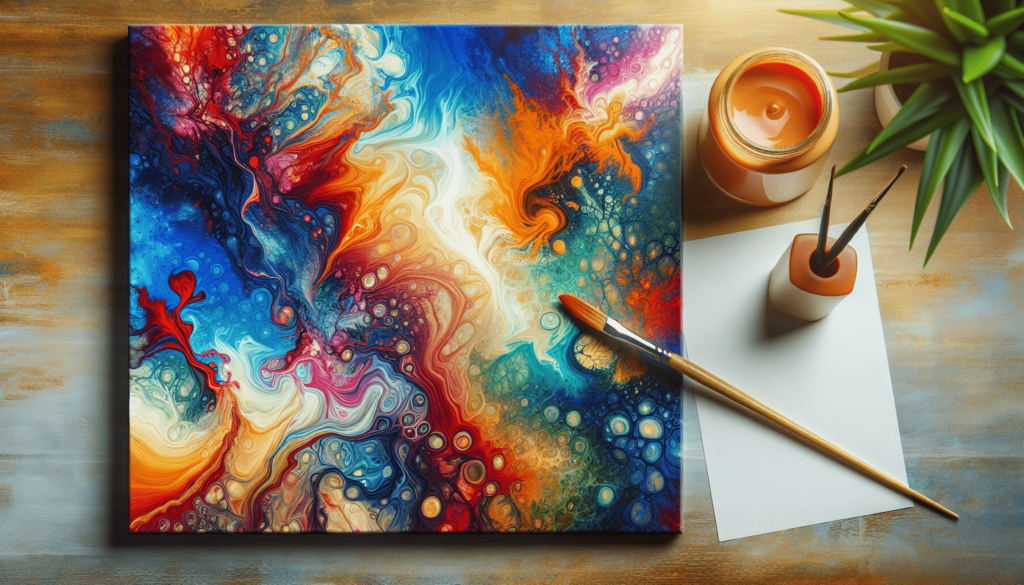Have you ever gazed at an acrylic pour painting and wondered how to ensure its vibrant colors and flowing patterns remain protected over time? As a meticulous creator who has invested time and effort into bringing a canvas to life, the last thing you want is for your artwork to lose its charm or get damaged. Sealing your acrylic pour painting is a crucial step in its preservation, ensuring both aesthetic longevity and durability.
Understanding Acrylic Pour Painting
Acrylic pour painting is a popular and visually striking technique that involves pouring fluid acrylic paint onto a canvas to create unique patterns and effects. This process harnesses the paints’ consistency and gravity to produce mesmerizing pieces that often mimic natural phenomena like marbled stone or flowing water. Each pour is distinct, making every artwork a one-of-a-kind creation. However, their fluid nature means they are susceptible to dust, moisture, and other environmental factors unless properly sealed.
Why Sealing Is Essential
The decision to seal your acrylic pour painting is not just about appearance; it’s essential for the protection and upholding the integrity of the artwork. Sealing helps in several ways:
-
Protection from Dust and Dirt: Without a sealant, your painting remains vulnerable to dust and dirt, which can dull the colors and disrupt the intricate patterns of acrylic pouring.
-
Prevention of Yellowing and Fading: Quality sealants can shield against harmful UV rays, preventing yellowing or fading over time.
-
Enhanced Color Vibrancy: Sealing can amplify the colors in your painting, giving them a richer, more vibrant look.
-
Surface Durability: A sealed surface is more resilient to scratches and minor abrasions, crucial for maintaining the piece during handling or transport.

Choosing the Right Sealant
Selecting the appropriate sealant for your acrylic pour painting is vital. The market offers various options, each with distinct attributes. Here’s an overview of different types of sealants to consider:
| Type of Sealant | Advantages | Considerations |
|---|---|---|
| Varnish | Enhances color richness, offers UV protection | May need thinning before application |
| Resin | Provides a glossy, glass-like finish | High VOC levels; requires proper ventilation |
| Polyurethane | Offers a durable, clear coat | Can sometimes cause yellowing with time |
Varnish
Varnish is widely used for sealing acrylic paintings due to its ease of application and protective qualities. Available in gloss, satin, and matte finishes, varnish can elevate your painting’s appearance while safeguarding it from environmental damage.
Resin
Resin offers a high-gloss, durable finish that is ideal for enhancing the depth and color of your pour painting. Although resin creates a stunning glass-like surface, it necessitates careful handling due to its chemical properties and should be applied in a well-ventilated space.
Polyurethane
Polyurethane sealers are known for their durability and clear finish. However, they can sometimes yellow over time, especially when exposed to light, making them more suitable for darker pour paintings.
Preparing Your Painting for Sealing
Before applying any sealant, preparing your painting is fundamental to achieving a smooth and successful seal. Follow these preparatory steps:
-
Curing: Allow your painting to fully cure. This process can take 4 to 6 weeks, ensuring the acrylic paint has completely hardened.
-
Cleaning: Gently wipe the surface with a soft, lint-free cloth to remove any dust or debris without harming the paint.
-
Leveling: Place your painting on a level surface to avoid any runs or drips in the sealant application.
-
Testing: Always test your chosen sealant on a small portion or a separate canvas to check for compatibility and desired finish.

Application Process for Different Sealants
The method of applying sealant can vary based on your choice. Below is a breakdown of how to apply the most common sealants effectively:
Applying Varnish
Varnish can be applied using a brush or spray:
-
Brush Application: Use a clean, wide, flat brush to apply varnish lightly across the surface. Work in thin layers and allow each layer to dry thoroughly before adding another.
-
Spray Application: Holding the can about 8-12 inches from the surface, spray in consistent, overlapping strokes. Be sure to cover the edges and corners adequately.
Applying Resin
Resin application requires precision:
- Mix resin with its hardener according to manufacturer instructions, typically using a 1:1 ratio.
- Pour the mixed resin onto the painting and use a spreader or a gloved hand to guide it evenly across the surface.
- Remove air bubbles using a blow torch or heat gun, keeping a safe distance to prevent scorching.
Applying Polyurethane
For polyurethane, a brush or foam applicator works best:
- Apply a thin, even coat using smooth strokes, ensuring there are no bubbles or streaks.
- Let it dry according to the manufacturer’s instructions before applying additional coats if needed.
Common Mistakes and Troubleshooting
Even with careful preparation and application, issues can arise. Here are some common mistakes and how to address them:
-
Streaks or Brush Marks: This often results from using the wrong brush or not applying varnish evenly. Sand lightly between coats to remove marks.
-
Bubbles in Resin: Occurs if air is trapped during mixing. Use a heat source like a torch to eliminate bubbles promptly after pouring.
-
Yellowing: Can happen with some sealants over time. Using high-quality, non-yellowing products or applying UV-resistant formulas can help mitigate this.
Final Touches and Maintenance
Once your painting is sealed, giving it some finishing touches and knowing how to maintain it will ensure its longevity:
-
Edge Sealing: Consider sealing the edges if your painting doesn’t have a frame. This will add an extra layer of protection.
-
Framing: Although not mandatory, framing can offer additional protection and enhance the display of your artwork.
-
Maintenance: Regularly dust your painting with a soft cloth and avoid direct sunlight exposure to maintain its vibrancy.
Conclusion
Sealing your acrylic pour painting is not merely a task for protection; it’s an artistic step that can elevate the allure and lifespan of your work. By understanding the types of sealants available and following a structured preparation and application process, you can preserve the brilliance and vitality of your creation for years to come. Now armed with knowledge, you’re ready to ensure your artwork remains as captivating and protected as the day you finished it.



